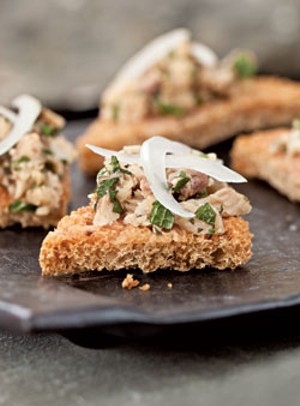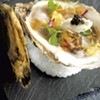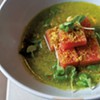Published April 6, 2011 at 10:23 a.m.
You really should be eating more sardines.
Sound like a hard sell? Possibly, because a dish of silvery little fish can bring to mind a pungent flavor not quite as enticing as that of, say, a creamy, basil-flecked pasta dish or a lightly charred lamb chop.
One spring afternoon just about a year ago, Lisa Gosselin, the editorial director of Charlotte’s EatingWell Media Group, was pondering sardines after editing contributor Carl Safina’s piece “Sea Change,” which touts them as a sustainable seafood choice. “We looked at all of the data and said, ‘Wow, this is a superfood everyone should be eating,’” says Gosselin. After all, sardines are richer in omega-3 oils than either salmon or tuna, ounce for ounce.
Gosselin talked with EatingWell’s Hilary Meyer, an assistant editor of food, a recipe developer and one of a handful of staff bloggers. Meyer drew on her Scandinavian background in a blog post for Yahoo titled “The #1 Food You Should Eat (and Probably Don’t).”
Meyer’s pitch for sardines struck a nerve, receiving 500,000 hits in a matter of days. Some of those ferried readers back to the EatingWell website, where they found recipes contributed by well-known chefs or developed by staff.
It was a prime example of the platform-crossing ethos that in nine years has transformed EatingWell from an adless, quarterly print magazine into a thriving media organism that runs one of the top food websites in the country, garnering more than 2 million hits per month. EW has won six James Beard awards and has 11 cookbooks under its belt. This year its authors have again been nominated for three James Beard Awards, including one for the company’s latest cookbook, The Simple Art of EatingWell.
That a publication can do this by running cover shots of virgin cherries, watermelon and oranges surprises at a time when many media outlets are showcasing “healthified” comfort food. “We’re the only magazine in America that has a food of less than 100 calories on the cover,” says Gosselin, holding up the photo of neon-green raw asparagus that graces the April 2011 EatingWell.
Yet the magazine is just half of a sprawling effort. EW draws the other half of its profits from its website — fed by daily blog posts for partners the Huffington Post, Yahoo and AOL — and from custom publishing projects that repurpose vetted recipes and content for supermarkets (such as Price Chopper), private firms and the military. EW’s recipe-laden “Eating Healthy Your Way,” for instance, is the only consumer publication distributed in army commissaries.
Some of the content EW packages for its many audiences is nuggetized and easily digestible — think “Recipes to Trim Your Waistline” and “10 Easy Ways to Meet the New Dietary Guidelines.” Other articles and recipes come from prominent voices such as nutritionist Marion Nestle, environmentalist Bill McKibben, and chefs Mario Batali, Bobby Flay and others. The common theme running through these diverse recipes and stories is a concern with the intersection of food and health, a strategic place from which EW rarely strays. Its dietary theory comes with practical recommendations — recipes — and vice versa.
In the case of the humble sardine, for example, those who found the blog post on Yahoo could click back to EW’s site for a handful of recipes, such as Tomato Toast With Sardines and Mint. That recipe was provided by Washington, D.C., chef Barton Seaver and, like every one in the magazine, was exhaustively tested in the EW test kitchen.
This aromatic room, with its bank of refrigerators and gas and electric stoves, its hundreds of cookbooks, and its three hulking kitchen islands, is the heart of EW’s offices. Here, a handful of recipe developers originate, assemble, sauté, bake or grill the recipes that end up in the magazine, on the site and in the cookbooks — often in all three.
One recent afternoon, deputy food editor Jessie Price gathers with recipe developers Meyer and Patti Cook for the first taste of a crab roll — essentially a lobster roll made with crabmeat. The dish is slated to appear in an upcoming installment of the magazine’s front-of -book section on weeknight meals that will focus on no-cook recipes.
Price bites into a wheat roll filled with a dollop of crabmeat blended with low-fat mayonnaise, lemon zest and juice, shallot, celery, chives and a dash of Tabasco. Lacy, red lettuce leaves poke from the side.
“I think it’s surprisingly delicious,” says Price. The women launch into a discussion of what kind of crabmeat to use, and which is easiest to find in the supermarket. Cook takes notes.
“We use Price Chopper as a benchmark in terms of a standard, large supermarket,” explains test-kitchen manager Stacy Fraser.
The EW recipe developers regularly tap some of the company’s 36 Charlotte employees for taste tests. The magazine’s typical demographic is female, ages 40 to 50, educated and relatively affluent — as well as busy. But the trio of twentysomething female staffers who come in to sample the crabmeat roll affirm its appeal.
Cook watches them carefully, pen in hand. One calls the dish “bright and summery tasting,” while another admits that, though she rarely eats seafood, she might try this again.
While this recipe may seem successful on the first try, most are tested five to seven times for flavor, texture, ease of assembly and visual appeal. “We try to simplify the recipe as much as possible,” says Fraser, as she watches recipe developer Carolyn Casner skewer chunks of lamb and eggplant for an upcoming feature on kebabs.
Even when the recipes come from chefs, “We sometimes try to poke holes in [them],” Casner says, to make sure they can be made easily with ingredients most people keep in their cupboards. Finally, EW’s three staff nutritionists analyze each dish to make sure it stays within stringent fat, sodium and nutritional parameters.
A new recipe continues its journey toward publication in the neighboring photo studio, where a hodgepodge of colorful plates, mugs and bowls line the walls. Here, photographer Ken Burris will try to capture every bead of moisture on a grilled pork chop, the slow ooze of cherries over the side of a waffle and, eventually, even the creamy sheen of a low-fat crabmeat roll.
The lush photos have stuck with EW through its various incarnations. The magazine was founded in 1990 by Charlotte resident James M. Lawrence, who parted ways with the publication about a year later. “He was probably ahead of his time,” says Gosselin of Lawrence, a creative fulcrum who has founded several publications and publishing companies, including Harrowsmith Country Life magazine.
In 1999, then-publisher Hachette Filipacchi shuttered the magazine due to what a company rep called “a lack of circulation and advertising support.” In 2002, Lawrence began to consider reviving it after EatingWell’s former nutrition editor, Elizabeth Hiser, proposed the idea to him.
Hiser later died in a car accident. At her memorial on Mount Philo — attended by many former EW staffers — Lawrence was moved to revive the magazine. “Seeing how deeply all these people cared about Betsy, who was the personification of EatingWell, I vowed to try to bring the magazine back, as she so passionately wanted,” writes Lawrence in an email.
Two years later, using $750,000 in venture capital from a consortium of private and local investors — including Shelburne’s Fresh Tracks Capital — Lawrence revived the title. The key partnerships with other media outlets began shortly after the magazine’s relaunch, some spearheaded by Larry Sommers, the general manager of business development.
Lawrence has left the company for personal reasons and now serves as editor and publisher of CORAL: The Reef Marine Aquarium Magazine. Gosselin joined EW in 2006 after serving as executive editor or editor-in-chief of a raft of publications, including Islands, Audubon and Bicycling magazines.
EatingWell Media Group remains private, so Gosselin doesn’t disclose revenues. But she does note that the group turned a corner into the black in 2009, at a time when the rest of the publishing industry was contracting. “It was the worst year for media, when Gourmet was on its final legs. We were lucky — we had no layoffs,” says Gosselin. The company remains profitable today.
EW filled one of the roles Gourmet abandoned when that other glossy publication met its demise — it runs feature stories on food history, origins and production. This year, two such features are nominated for James Beard awards: Rachael Moeller Gorman’s “Captain of the Happier Meal” and Safina’s “Sea Change.”
“I really appreciate that they dig a little deeper than most publications and really try to provide insight and education in their pieces,” says renowned Northern California chef John Ash, an EW contributor.
The nutritional and culinary education EW provides may seem like a no-brainer to many Vermonters. But travel up Route 7 from EW’s headquarters to the Price Chopper in South Burlington, and the bottles of Coca-Cola Zero and frozen pizzas that fill carts reveal another reality, in which not everyone can afford to buy fresh produce, and not everyone wants to.
Gosselin and Price say it doesn’t have to be that way. “We analyze our recipes, and most of them come in under $3 a meal,” says Gosselin. She adds that the magazine — now at 350,000 circulation and an estimated 1.75 million readers — translates Vermont’s agricultural and localvore ethos for the world at large. “The entire world is gradually moving closer to our space,” she observes.
What about ink-and-paper purists who worry that EW’s resurgence as a profitable online content provider spells the eventual end of the magazine and its high standards?
For them, Gosselin offers assurances. “Print is where we start most of our stories,” she says.
But stories that only appear in print can “die” in just a few months. “We find ways to make that story live on — on the web or in a book or [distributed] by a health care company that has to educate their employees,” Gosselin says. As the story makes the rounds of various media, it uses its EW origin as a calling card. “[Other companies] know the recipes have been vetted, researched and fact-checked,” Gosselin explains. “There are tons of sites out there, but the foundation recipe we give you, you know it’s going to work.”
Reader trust: It’s but one facet of the strategy that made a niche publication into a brand powerful and creative enough to sell sardines.
More By This Author
Speaking of...
-

Q&A: Howard Fisher Delivers Meals on Wheels With a Side of Good Cheer
Dec 20, 2023 -

Video: Howard Fisher Delivers Meals on Wheels
Dec 14, 2023 -

Q&A: Alexis Dexter Rescued 57 Shelter Cats During the July Flood
Sep 13, 2023 -

Video: Two Months After the Flood, Alexis Dexter Rebuilds Kitty Korner Café in Barre and Continues to Rescue Cats
Sep 7, 2023 -

Williston Tech Company Polly Lays Off 17 People in Vermont
Dec 5, 2022 - More »
Comments
Comments are closed.
From 2014-2020, Seven Days allowed readers to comment on all stories posted on our website. While we've appreciated the suggestions and insights, right now Seven Days is prioritizing our core mission — producing high-quality, responsible local journalism — over moderating online debates between readers.
To criticize, correct or praise our reporting, please send us a letter to the editor or send us a tip. We’ll check it out and report the results.
Online comments may return when we have better tech tools for managing them. Thanks for reading.















































